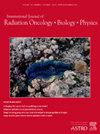CDK4/6抑制剂和放疗与抗PD-L1免疫疗法在三阴性乳腺癌中的协同潜力
IF 6.4
1区 医学
Q1 ONCOLOGY
International Journal of Radiation Oncology Biology Physics
Pub Date : 2024-10-01
DOI:10.1016/j.ijrobp.2024.07.071
引用次数: 0
摘要
目的/目标:三阴性乳腺癌(TNBC)是所有乳腺癌分子分类中生存率最差的亚型。虽然免疫疗法在 TNBC 治疗中显示出良好的抗肿瘤效果,但其疗效并非对所有患者都适用。CDK4/6 抑制剂被认为具有放射增敏和调节免疫系统的能力。此外,据观察,大剂量放疗(RT)可增强免疫疗法的效果。材料/方法 我们采用三种人类 TNBC 细胞系--MDA-MB-231、MDA-MB-453 和 MDA-MB-468--以及 4T1 小鼠 TNBC 细胞系,使用克隆形成试验评估 CDK4/6 抑制剂阿柏西尼对 TNBC 的放射增敏作用。我们通过4T1细胞系衍生的免疫功能健全小鼠模型评估了RT、abemaciclib和抗PD-L1抗体组合的抗肿瘤疗效。在治疗前、治疗中和治疗后监测小鼠血液中的干扰素-γ(IFN-γ)水平,以评估免疫反应。通过流式细胞术检测和免疫组化染色分析了切除肿瘤样本中的肿瘤浸润淋巴细胞(TILs)。结果细胞周期检测显示,RT 联合阿贝昔单抗预处理对所有测试的 TNBC 细胞系都有协同作用。单次 8 Gy 分量的 RT 可增加肿瘤细胞表面的 PD-L1 表达,而阿贝替尼(浓度为 100nm 或 200nm)不会改变所有 TNBC 细胞系中的 PD-L1 表达。在4T1小鼠模型中,与对照组、单用RT组、阿培莫司利与抗PD-L1组、阿培莫司利与RT组、抗PD-L1与RT组相比,阿培莫司利、RT和抗PD-L1组在治疗过程中能显著降低肿瘤生长(P< 0.05)和升高循环IFN-γ水平(P< 0.001)。TILs检测结果显示,与对照组相比,阿巴西利、RT和抗PD-L1联合治疗可增加CD4和CD8阳性T细胞比例(分别为P <0.05和P <0.01)以及肿瘤相关巨噬细胞(P <0.001)。免疫组化染色显示,与其他四组相比,三联治疗组 CD8 阳性 T 细胞和单核细胞趋化蛋白(MCP)-1 阳性巨噬细胞增加。本文章由计算机程序翻译,如有差异,请以英文原文为准。
Synergistic Potential of CDK4/6 Inhibitors and Radiotherapy with Anti-PD-L1 Immunotherapy in Triple-Negative Breast Cancer
Purpose/Objective(s)
Triple-negative breast cancer (TNBC) represents the subtype with the poorest survival outcomes among all breast cancer molecular classifications. While immunotherapy has shown promising anti-tumor effects in TNBC treatment, its efficacy is not universal across all patients. CDK4/6 inhibitors have been recognized for their ability to radiosensitize and modulate the immune system. Additionally, high-dose radiotherapy (RT) has been observed to bolster the effects of immunotherapy. This study investigates the potential of enhancing immunotherapy effectiveness in TNBC by integrating RT with CDK4/6 inhibitors, focusing on modulating the tumor microenvironment.
Materials/Methods
We employed three human TNBC cell lines—MDA-MB-231, MDA-MB-453, and MDA-MB-468—along with the 4T1 mouse TNBC cell line to assess CDK4/6 inhibitor, abemaciclib, in radiosensitizing effects of TNBC using the clonogenic assays. We assessed the anti-tumor efficacy of RT, abemaciclib, and anti-PD-L1 antibody combination through the 4T1 cell line-derived immunocompetent mouse model. Interferon-γ (IFN-γ) levels in mouse blood were monitored before, during, and after treatment to gauge the immune response. Tumor-infiltrating lymphocytes (TILs) were analyzed in excised tumor samples through flow cytometry assays and immunohistochemical staining.
Results
Clonogenic assays showed that RT combined with abemaciclib pretreatment had synergistic effects across all tested TNBC cell lines. A single 8 Gy fraction of RT increased PD-L1 expression on the surface of tumor cells, while abemaciclib (at 100nm or 200nm concentrations) did not alter PD-L1 expression in all TNBC cell lines. The combination of abemaciclib, RT, and anti-PD-L1 in the 4T1 mouse model significantly decreased the tumor growth (P < 0.05) and elevated circulating IFN-γ levels during treatment (P < 0.001) when compared with control, RT alone, abemaciclib with anti-PD-L1, abemaciclib with RT, and anti-PD-L1 with RT. TILs assays showed the combination treatment of abemaciclib, RT, and anti PD-L1 increased CD4 and CD8 positive T cells proportion (P < 0.05 and P <0.01, respectively) as well as tumor associated macrophage (P < 0.001) when compared to the control group. Immunohistochemical staining revealed an increase in CD8 positive T cells and monocyte chemoattractant protein (MCP)-1 positive macrophages in the triple-combination treatment group compared to the other four groups.
Conclusion
Combined CDK4/6 inhibitors with RT enhance anti-tumor effects of anti-PD-L1 immunotherapy in TNBC through increasing secretion of IFN-γ and modulation of tumor microenvironments via recruiting CD4 and CD8 positive T-cells, as well as M1 type tumor associated macrophage.
求助全文
通过发布文献求助,成功后即可免费获取论文全文。
去求助
来源期刊
CiteScore
11.00
自引率
7.10%
发文量
2538
审稿时长
6.6 weeks
期刊介绍:
International Journal of Radiation Oncology • Biology • Physics (IJROBP), known in the field as the Red Journal, publishes original laboratory and clinical investigations related to radiation oncology, radiation biology, medical physics, and both education and health policy as it relates to the field.
This journal has a particular interest in original contributions of the following types: prospective clinical trials, outcomes research, and large database interrogation. In addition, it seeks reports of high-impact innovations in single or combined modality treatment, tumor sensitization, normal tissue protection (including both precision avoidance and pharmacologic means), brachytherapy, particle irradiation, and cancer imaging. Technical advances related to dosimetry and conformal radiation treatment planning are of interest, as are basic science studies investigating tumor physiology and the molecular biology underlying cancer and normal tissue radiation response.

 求助内容:
求助内容: 应助结果提醒方式:
应助结果提醒方式:


